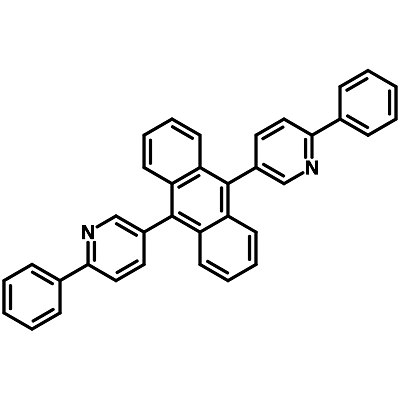Charge Transport Layer Materials, High Purity Sublimed Materials, Materials, OLED Materials


DPPyA (CAS number 1257879-34-7), or 9,10-bis(6-phenylpyridin-3-yl)anthracene, consists of an anthracene core joined by two phenylpyridine units. With two adjacent pyridine units, it is electron deficient. As a result, DPPyA is normally used as an electron transport layer material, either by itself, or together with Liq as dual electron transport layer materials in organic light-emitting diodes.
The pyridine units of DPPyA not only facilitate charge injection, but also enhance the electron-transporting mobility, benefitting from the closely packed molecules induced by the intermolecular H---N hydrogen bonding. DPPyA achieved high electron mobility of 1.5 × 10− 3 cm2/Vs under the electric field of 5.5 × 105 V/cm due to the existence of good molecular stacking.
Owing to its high electron mobility, lower operation voltages and high current densities can be observed in devices with DPPyA as electron transport layer material.
| CAS number | 1257879-34-7 |
|---|---|
| Chemical formula | C36H24N2 |
| Molecular weight | 484.59 g/mol |
| Absorption | λmax 379, 401 nm |
| Fluorescence | λem 439 nm |
| HOMO/LUMO | HOMO = 5.9 eV, LUMO = 3.0 eV [1] |
| Full name | 9,10-bis(6-phenylpyridin-3-yl)anthracene |
| Synonyms | DPPyA |
| Classification / Family | Anthracene derivatives, electron transport layer materials, sublimed materials, TADF materials, OLEDs, organic electronics |
| Purity | Sublimed* >99.0% |
|---|---|
| Melting point | Tg = 135 °C, |
| Colour | White Powder |
Sublimation is a technique used to obtain ultra pure-grade chemicals. For more details about sublimation, please refer to the Sublimed Materials for OLED devices page.
 Chemical structure of 9,10-bis(6-phenylpyridin-3-yl)anthracene (DPPyA), CAS 1257879-34-7
Chemical structure of 9,10-bis(6-phenylpyridin-3-yl)anthracene (DPPyA), CAS 1257879-34-7专业代理国外知名镊子品牌
我们将竭诚为你服务
0755-23003036